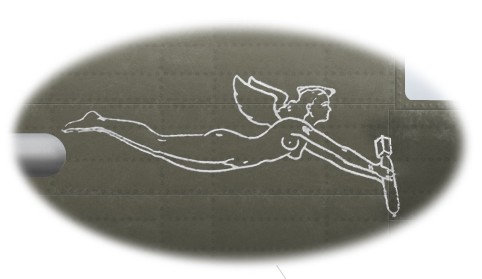 1. B-25B 40-2242 and its crew belonged to the 95th Bomb Squadron of the 17th Bomb Group. Its crew was composed of pilot Capt. Edward J. York, copilot Lt. Robert G. Emmens, navigator Lt. Nolan A. Herndon, bombardier SSgt. Theodore H. Laban and engineer/gunner Sgt. David W. Pohl. The aircraft, the eighth to take off from the USS Hornet, had suffered engine problems prior to the raid and had heavy fuel consumption while enroute to its target. In addition, the top turret malfunctioned and was inoperative, leaving the aircraft very vulnerable. Despite all this, Captain York and his men elected went on to bomb their assigned target in the Tokyo area but elected to make for Russia, as China was too far away. They landed at a field near Vladivostok, where the airplane was taken into custody by then-neutral Russia and the crew interned. After thirteen months of captivity, the crew escaped to Persia and returned home in May 1943. The aircraft was used by the Russians and was probably scrapped in 1950.
1. B-25B 40-2242 and its crew belonged to the 95th Bomb Squadron of the 17th Bomb Group. Its crew was composed of pilot Capt. Edward J. York, copilot Lt. Robert G. Emmens, navigator Lt. Nolan A. Herndon, bombardier SSgt. Theodore H. Laban and engineer/gunner Sgt. David W. Pohl. The aircraft, the eighth to take off from the USS Hornet, had suffered engine problems prior to the raid and had heavy fuel consumption while enroute to its target. In addition, the top turret malfunctioned and was inoperative, leaving the aircraft very vulnerable. Despite all this, Captain York and his men elected went on to bomb their assigned target in the Tokyo area but elected to make for Russia, as China was too far away. They landed at a field near Vladivostok, where the airplane was taken into custody by then-neutral Russia and the crew interned. After thirteen months of captivity, the crew escaped to Persia and returned home in May 1943. The aircraft was used by the Russians and was probably scrapped in 1950.

2. B-25B 40-2268 was the last aircraft to take-off from the USS Hornet’s deck. Its crewmembers were from the 89th Reconnaissance Squadron of the 17th Bomb Group. Its crew was composed of pilot Lt. William G. Farrow, copilot Lt. Robert L. Hite, navigator Lt. George Barr, bombardier Cpl. Jacob DeShazer and engineer-gunner Sgt. Harold A. Spatz. Taking off 59 minutes after Doolittle, the crew knew they would be facing alerted Japanese defences. When they took off, a sailor from the Hornet slipped and fell into the propeller arc, losing an arm. Despite this bad omen, they bombed oil storage tanks and an aircraft factory near Nagoya in the face of enemy fighter attacks before heading for China. Because their fuel was low, Lt. Farrow ordered the crew to bail out near the Japanese-held city of Nangchang. Within an hour the entire crew had been captured by Japanese troops. Farrow and Spatz, along with Lt. Hallmark of the 6th aircraft, were executed by the Japanese on October 15, 1942. The rest of the crew was liberated at the end of the war. DeShazer later became a missionary and as such returned to Japan for several years.
 4. B-25B 40-2249 “Hari Kari-er” (or “Hari Carrier” according to some sources) and was the 11th aircraft to launch from USS Hornet’s deck. Its crew was composed of pilot Capt. Charles R. Greening, copilot Lt. Kenneth E. Reddy, navigator Lt. Frank A. Kappeler, bombardier SSgt. William L. Birch and engineer/gunner Sgt. Melvin J. Gardner, all from the 89th Reconnaissance Squadron.
4. B-25B 40-2249 “Hari Kari-er” (or “Hari Carrier” according to some sources) and was the 11th aircraft to launch from USS Hornet’s deck. Its crew was composed of pilot Capt. Charles R. Greening, copilot Lt. Kenneth E. Reddy, navigator Lt. Frank A. Kappeler, bombardier SSgt. William L. Birch and engineer/gunner Sgt. Melvin J. Gardner, all from the 89th Reconnaissance Squadron. 

5. B-25B 40-2261 was nicknamed “The Ruptured Duck” and was crewed by members of the 95th Bomb Squadron, 17th Bomb Group: pilot Lt. Ted W. Lawson, copilot Lt. Dean Davenport, navigator Lt. Charles L. McClure, bombardier Lt. Robert S. Clever and engineer/gunner Sgt. David J. Thatcher.


6. B-25B 40-2270, also known as “Whiskey Pete” was crewed by members of the 95th Bomb Squadron of the 17th Bomb Group: pilot Lt. Robert M. Gray, co-pilot Lt. Jacob E. Manch, navigator Lt. Charles J. Ozuk, bombardier Sgt. Aden E. Jones and engineer/gunner Cpl. Leland D. Faktor.